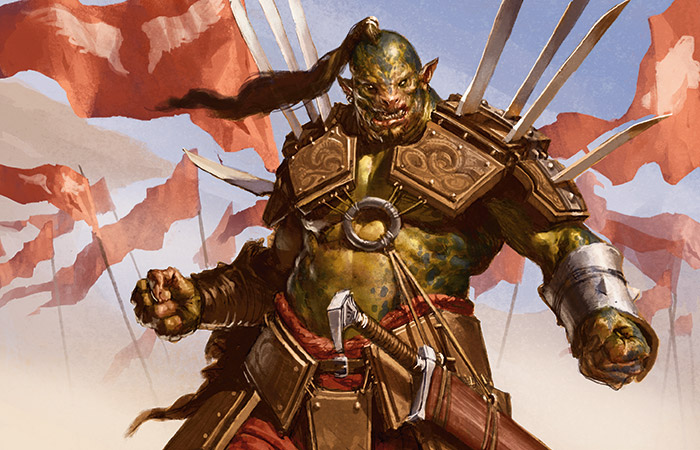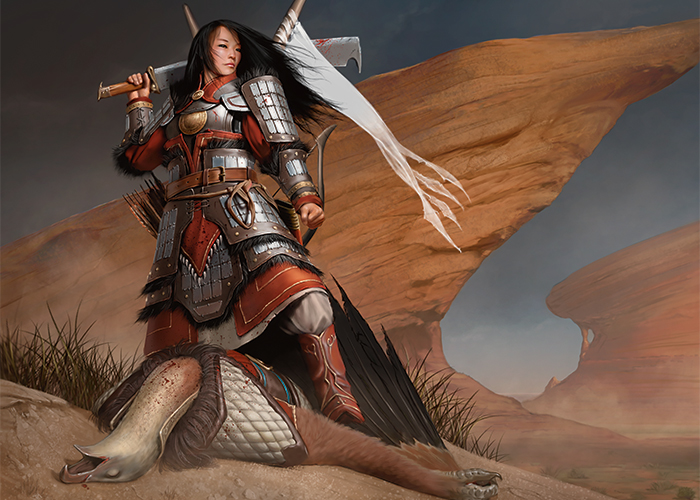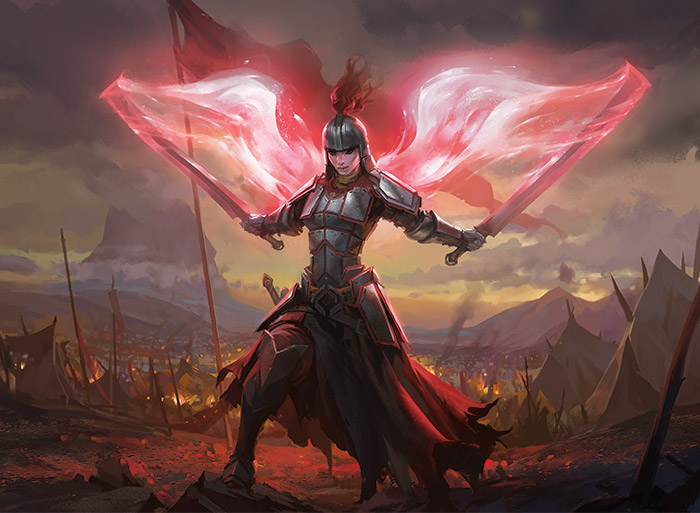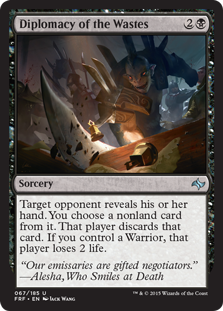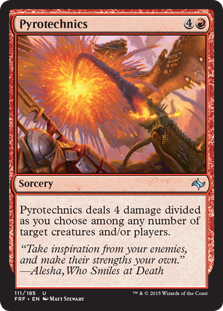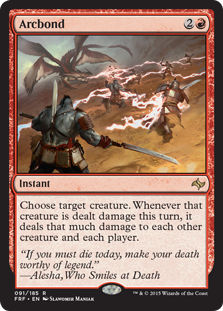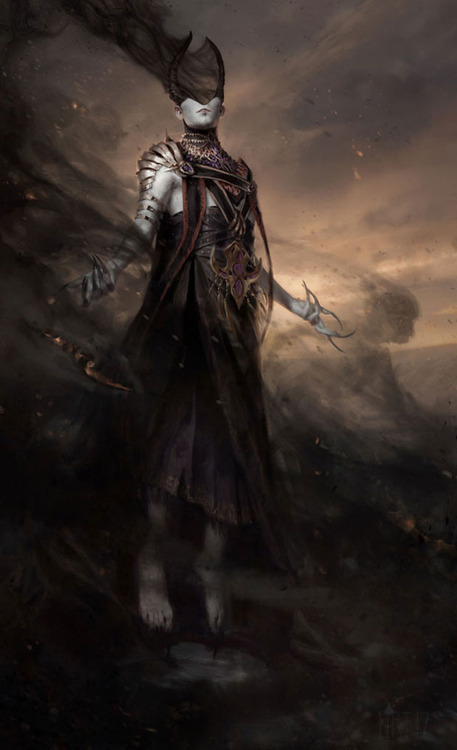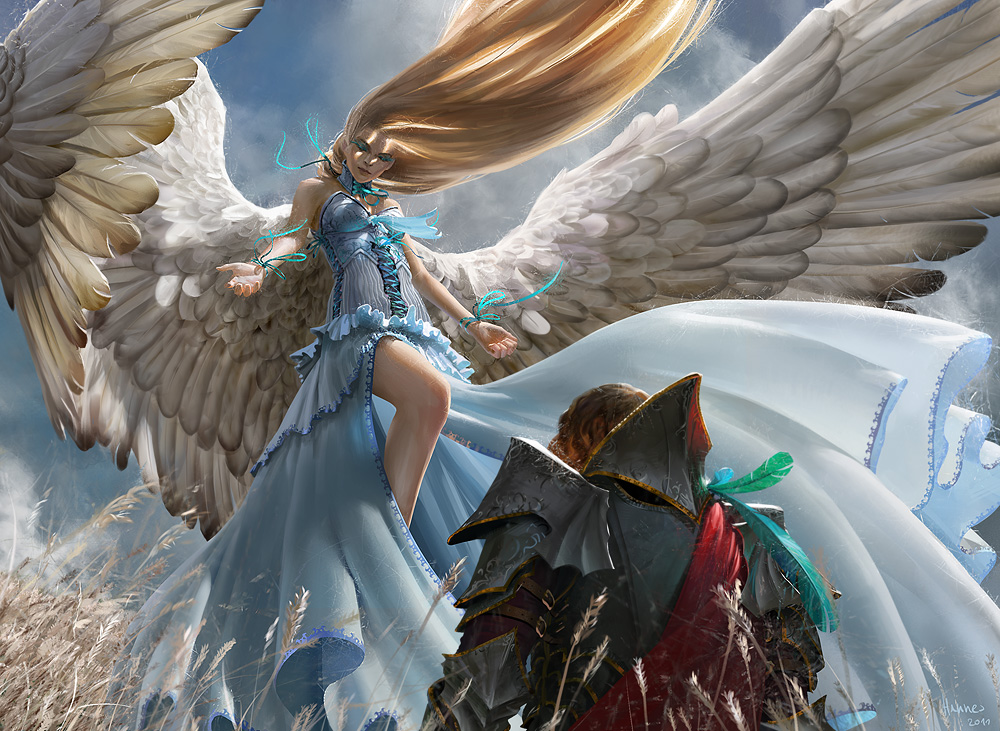By Harry Huberty and Christina Ladd
—
Welcome back to Spells and Whistles! In our sign-off last time, we indicated that we planned to talk planeswalkers this week.
We’re putting that on hold, though, since something more topical happened after our column went to press: WotC revealed in their “Uncharted Realms” column that Mardu khan Alesha, Who Smiles at Death, is a transgender character. Alesha’s gender identity was confirmed by Magic creative team member Doug Beyer on his Tumblr, as well as Magic Head Designer Mark Rosewater.
This news was met with an outpouring of support and praise for Alesha–it seems many, many fans are very happy about this decision, which is great news in its own right. On the heels of our discussion of the art for the khans of Fate Reforged, we thought Alesha deserved some more discussion.
Harry: You should definitely read the story (by James Wyatt, with contributions from Matt Knicl and Allison Medwin), but here’s a quick summary: it describes Alesha leading the Mardu in A battle against six dragons, which becomes the backdrop for Alesha recounting the day she earned her “war name.” For the Mardu, one becomes a warrior only through a glorious act of honor or valor in battle, often through killing an enemy.
Normally these war names commemorate that valorous moment, so you see a lot of names like “Helmsmasher” or “Wingbreaker.” But when Alesha earned hers, she chose the name “Alesha”—her grandmother’s name. In the moment of the ceremony, the Mardu accept her unconditionally: she has won her war name, and with that comes the right to articulate her own identity.
Christina: I would like to know more about this grandmother, and also about Mardu given (i.e., not earned) names. Is it like our society, in which we often give the names of beloved family members to our children in homage? Or is taking her grandmother’s name unusual? What does Alesha mean in her language? I think it says a lot of good things about this story that I want to know more about Mardu culture.
H: I was pretty curious as well. It pulls some story weight, since taking a grandmother’s name makes Alesha’s gender identity concrete, but it also suggests Alesha admires her grandmother in some significant ways.
In the present, three years later, Alesha has become khan of the Mardu, but there are a few who don’t accept her for who she is. In particular, the story describes a young orc, who chafes under the leadership of “a human boy who thinks he’s a woman.” This orc is also not in the traditional Mardu mold: he fights to protect his clanmates and defers his own killing blows so that others will survive.
This orc doesn’t have a war-name yet, because he doesn’t see what he does as being as sufficiently glorious. But Alesha challenges him to know himself, and claim his identity. By the end of the story, this orc gives Alesha her full title “Who Smiles at Death”—a sign that he accepts who Alesha is, even if he’s still figuring himself out.
C: It’s a bit of a quick shift to go from insulting your khan by challenging her very war-name to giving her a new epithet and your service. I imagine there must be constraints on the length of this story, however, and the point is made: Alesha has earned her status and the respect of her clan as much as her name.
To earn your gender is not really part of our culture; we see it as innate. But many trans individuals have unfortunately had to earn their identities, painfully and painstakingly, from their communities. To see that narrative turned on its head and understood as a glorious coming-of-age rite—one that everyone experiences to some degree—is very appealing, and I think perhaps something that merits a much larger discussion.
H: This “war name” idea is the sort of neat anthropological footnote that enriches our sense of a fictional culture, but usually functions as a toss-off. Rarely do we see the implications of an initiation rite explored in this manner. So it’s cool to see that Wizards can do some work with this.
The “war name” custom affords Alesha the opportunity to articulate her own identity, and I give the authors a bunch of credit for having the Mardu accept her identity as she presents it. There was a different path here, which would have had the Mardu khan push back, and I think there would have been a lot of melodrama with very little payoff.
C: They also don’t play coy with any of the art, which I appreciate immensely. Like the horde, the viewer is not invited to challenge her identity. There’s no “tee hee what is under this outfit” nonsense—Alesha is always in her full battle regalia, which brooks no inappropriate questions. She’s a khan, a warrior, and a woman.
H: As a straight white cismale, I can’t speak to the experiences of transgender people myself. But I do think this story was handled very well. In particular, I appreciate that it’s a story about transgender characters, but it’s not strictly ABOUT BEING TRANSGENDER. The authors allow the themes of name and identity to play off each other, and they give Alesha time to do a lot of things, not “just” be a transgender character.
One of the privileges that comes with being straight and male is that I don’t have to be aware of my gender at all times. On the other hand, a lot of stories about transgender people are all about that identity—the person is constantly aware of it and everything in the story hinges on it and orbits around it. As Tumblr user “phorgewerk” writes to WotC’s Doug Beyer, “It’s so nice to finally start seeing trans characters who aren’t sob transition stories or cruel jokes.” It’s its own kind of reductive.
Alesha’s identity as a transwoman matters, but lots of other stuff matters too. This gives Alesha the opportunity to occupy/embody/participate in a number of different roles: warrior, leader, tactician, mentor, advisor. Human. She’s a character, not an allegory or a symbol.
C: I would be more cautiously optimistic in that regard. Alesha is the first trans character for MTG. She is in some ways necessarily a symbol. They’ve done well by her, but it remains to be seen whether they put a check in the diversity box and move on. (I don’t think they will, they seem committed to improving diversity, but there is that risk.)
H: It’s a great point. One opportunity (probably past them, now, given the schedules for printing cards) would be to have cards in Dragons of Tarkir call back to Alesha, so that we can see her impact in Tarkir’s (alternate) future. There are always supplemental products, like Commander. They do a decent job with Alesha’s flavor text quotes in Fate Reforged, though:
Badass, no?
Alesha, as Magic’s first canonically transgender character, is the latest in a line of moves from Wizards of the Coast that is pushing forward with representing all types of identities in the game.
Last fall, in the Theros expansion, they introduced the planeswalker [mtg_card]Ashiok, Nightmare Weaver[/mtg_card], whose gender identity is “officially unspecified.”
This didn’t take off quite as well. There were a few gaffes, like using the masculine pronoun “der” on the German version of Ashiok, and calling Ashiok “he” in some English promo materials. But a segment of the audience seemed to have trouble accepting Ashiok as Ashiok was presented; lots of people wanted to know the “real answer.” To Doug Beyer’s credit, he challenged those asking the questions—to recognize that wanting to know Ashiok’s “real” gender betrays a lot of assumptions and reflects an ingrained need to categorize according to an artificial binary.
More subtly, the flavor text on Guardians of Meletis hints at two male lovers:
And as we mentioned last week, the art on Innistrad’s [mtg_card]Rakish Heir[/mtg_card] was a conscious move toward sexualized representations of male characters in fantasy art, to balance out sexualized representations of female characters.
C: While I do applaud Magic for that “balance,” so to speak, I am more interested in seeing non-sexualized female characters to balance the plethora of non-sexualized males. Yes, sexuality is an important part of many cultures, and should be represented where thematically appropriate. But equal exploitation is still exploitation! I don’t necessarily want men in silk boxers just because we have Sexy Bo Peep; I just want an angel of restoration to not show up in her nightie:
H: Also a great point. Sexualized male characters don’t necessarily address the underlying dynamics. It’s important that WotC keep pushing forwards in this area—after all, about a week ago we had a Super Bowl ad for a free-to-play war game that featured Kate Upton taking a bath and riding a horse.
Fantasy gaming is a big tent, and there’s plenty of space for people of all identities to play. It’s equally important that people of all identities see themselves represented.
That goes for all media, but it’s especially crucial for Magic, where so much philosophy and outlook and worldview is represented right there in the game’s mechanics and flavor. Magic allows for identification on a very deep level, and so there need to be more diverse representations, so that everyone can participate in that aspect of the game.
—
We’ll be back next week to talk about Magic’s planeswalkers, including the new art for this summer’s release, Magic Origins, which was previewed this past weekend at Pro Tour Fate Reforged. Thanks for reading, and please weigh in with your comments!


